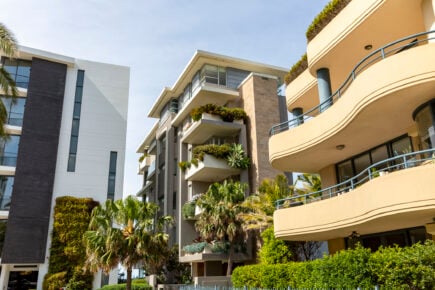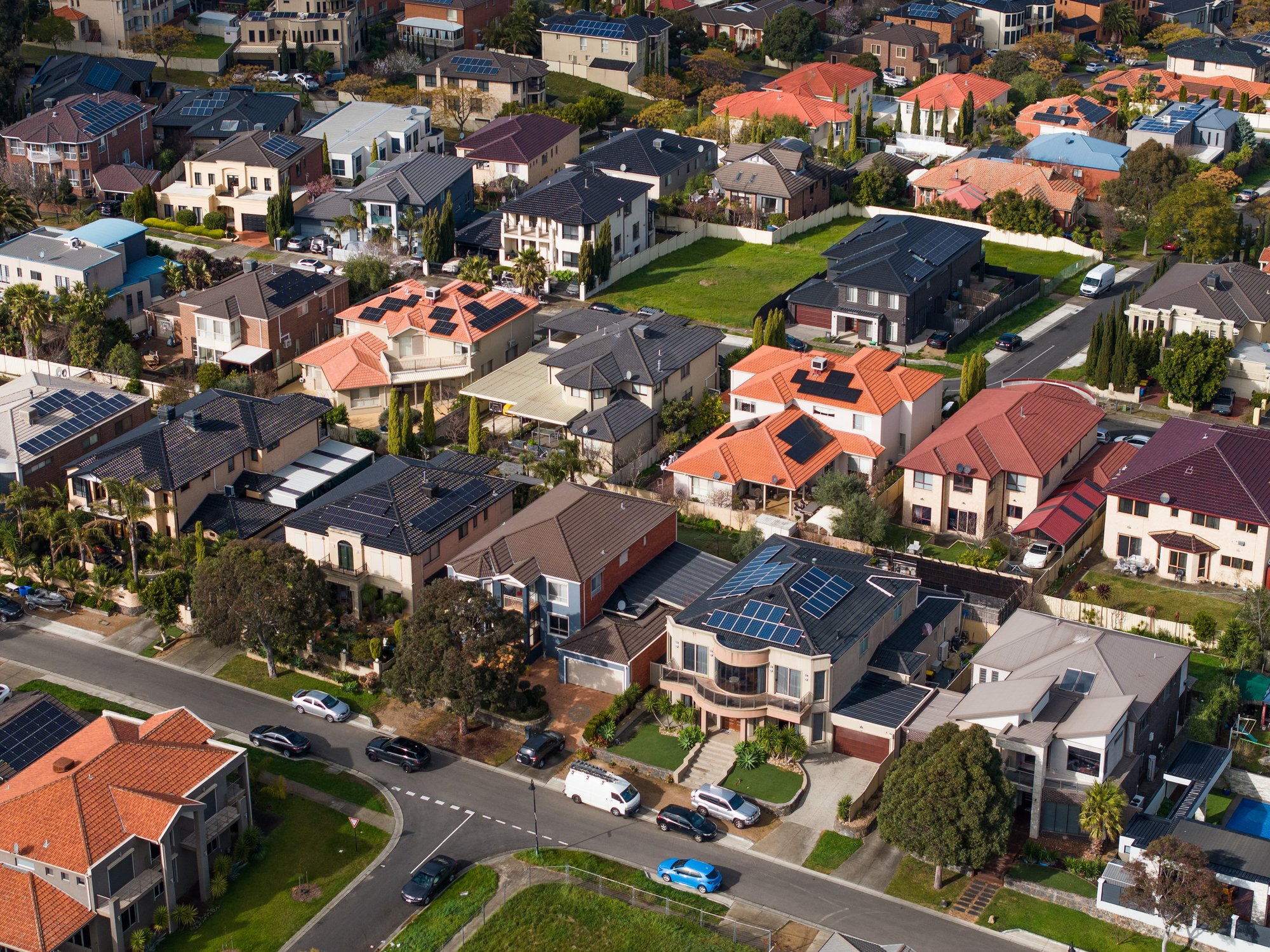As a first home buyer, you must consider many factors before you decide to get a home loan and become a property owner. Understanding the key differences between a townhouse, house and apartment will help clarify your decision-making.
- A house is a property separated from other dwellings by at least half a metre.
- A townhouse is usually considered a semi-detached dwelling with private grounds and no other dwelling attached above or below. Townhouses usually connect to neighbouring dwellings in some structural way.
- An apartment has no private grounds but shares a common entrance, foyer or stairwell.
Latest figures from the Australian Bureau of Statistics[1] revealed that separate houses accounted for 70% of all dwellings in Australia, while 13% were townhouses and 16% were apartments.
Path to homeownership
There are several steps along your path to homeownership, starting with significant financial preparation that considers your borrowing power, income, expenses and credit history.
You can also set your goals regarding size, price and the type of property you plan to buy. Standard home loans in Australia require a 20% deposit to avoid paying lenders mortgage insurance (LMI). And, if you want to buy a house, you may need a larger deposit or a longer mortgage term, depending on your circumstances.
Prices for these types of properties vary widely nationwide. As a first home buyer, though, you will likely require a smaller mortgage if you are in the market for a townhouse or apartment.
Your purchase timeline will depend largely on how long it will take to save for the deposit and the supply and demand of properties you may wish to buy. In regional areas, apartments may be more scarce than freestanding houses, while finding them for sale in capital cities may be harder.
Other factors to consider include:
- choosing the right type of home loan
- getting home loan pre-approval
- running a property search
- making an offer or attending auctions
- completing building and pest inspections
- exchanging contracts.
Cost
The largest upfront cost will be the property’s purchase price. The more expensive the property, the higher the deposit you will require.
Purchasing cost of a townhouse vs house vs apartment
Other upfront costs
In addition to the deposit, there are other upfront costs of buying a home to consider.
Lenders mortgage insurance
If you do not have a 20% deposit for the property you wish to buy, you may need to pay LMI. This once-off, upfront payment protects the lender should you default on your mortgage. The cost will depend on your deposit and the size of the loan.
Legal and conveyancing fees
Solicitors and conveyancers act as an intermediary between you and the lender. They help prepare documents, contracts, land transfers, and more. The fees will depend on the property size and can be as high as $2000.
Stamp duty
Also known as transfer or conveyance duty in Australia, stamp duty is a one-off tax the buyer pays on the transfer of property ownership. Stamp duty amounts vary between states and territories.
Building and pest inspections
A building inspection is not compulsory but is often necessary to check the property’s structural integrity. Similarly, a pest inspection will check for issues with insects such as termites. These inspections can cost a few hundred dollars.
Ongoing costs
Insurance
Many homeowners pay home and contents insurance to protect their property and belongings. The cost depends on the level of coverage you choose, but it usually runs between $1400 and $2500 per annum.
Body corporate
Most apartments and townhouses belong to a strata title, meaning you pay body corporate fees for managing and maintaining shared spaces such as garages, gardens and pools.
Council fees
These are quarterly fees payable to your local government for the land. The cost will depend on your property. If you own a strata title property, corporate fees may also cover this.
Size, space and location
Houses are, on average, more expensive than apartments or townhouses and are usually larger.
Average size: townhouse vs house vs apartment
When comparing property types, townhouses are generally made to mimic floorplans of houses with dual-level living. Additionally, purchasing a townhouse or apartment may give you access to other facilities you wouldn’t be able to afford with a freestanding house, such as a pool or gym.
When searching for various property types, you can find a larger number of apartments and townhouses in inner-city areas. In recent years, this trend has grown as more semi-detached dwellings are built in capital cities.
For example, in 2001, detached houses comprised 63% of dwellings in the greater Sydney region. By 2021, however, this number had fallen to 55.8%, while the percentage of apartments and semi-detached dwellings increased.
Meanwhile, detached housing still makes up 70% of all dwellings in Australia, according to ABS data, meaning Sydney has a much higher representation of apartments and townhouses than other parts of the country.
For example, less-populated capitals such as Perth and Hobart have a higher percentage of detached houses than Sydney and Melbourne.
Maintenance and responsibilities
Apartments and townhouses usually require less upkeep than houses, which are freehold properties. So, the homeowner is responsible for maintaining areas such as front and back yards. For townhouse or apartment owners, these areas typically fall under the responsibility of the body corporate.
While the extra maintenance may be a negative, freehold properties allow you, the owner, to make renovations (though you may still require council approval). Townhouse and apartment renovations, on the other hand, almost always require body corporate approval.
Community and lifestyle
Your lifestyle and budget may also influence your choice between a house, townhouse or apartment. You might have already picked your dream suburb close to bars, restaurants, and the CBD for an easy commute to work. However, this may mean you have to settle for an apartment due to cost and availability.
Apartments and townhouses tend to be more available close to cities, but you may need to sacrifice some privacy. Shared walls, hallways and facilities mean living in close proximity to neighbours.
Alternatively, you may need a family home with extra bedrooms and a backyard. These needs might push you towards a house that’s further outside the CBD or in a regional suburb.
Important lifestyle factors to consider when making the decision include:
- community
- proximity to parks, cafes and restaurants
- space for pets, children and hobbies
- privacy
- parking
- commute distance to work
- access to public transport.
Additional tips
When buying a property, there are many long-term factors to consider, and researching the property type and suburb can be a big benefit. For example, the property market resale value of apartments and townhouses may be lower if an influx of such dwellings is expected in your neighbourhood.
Long-term factors to consider include:
- potential to make capital gain when you sell
- ability to use the dwelling as an investment property
- data about the suburb
- ability to renovate
- property condition
- future development in the area.
Article Sources
-
Australian Bureau of Statistics (2021), “Housing: Census,” accessed April 4, 2024.
DIVE EVEN DEEPER

Is Buying a House With a Friend a Good Idea?
Should you buy a house with a friend? It depends. Involving others often leads to lower costs, but can result in more complications.

Lease Vs. Rent: What’s the Difference in Australia?
The terms lease and rent are often used interchangeably in Australia, but they actually mean different things when it comes to property.

What Is A Rental Bond?
Beyond weekly payments, one of the largest costs associated with renting is likely your rental bond.

When One Partner Owns the House
Here’s what you need to know about property settlements, joint registration, sole registration and cohabitation agreements.

